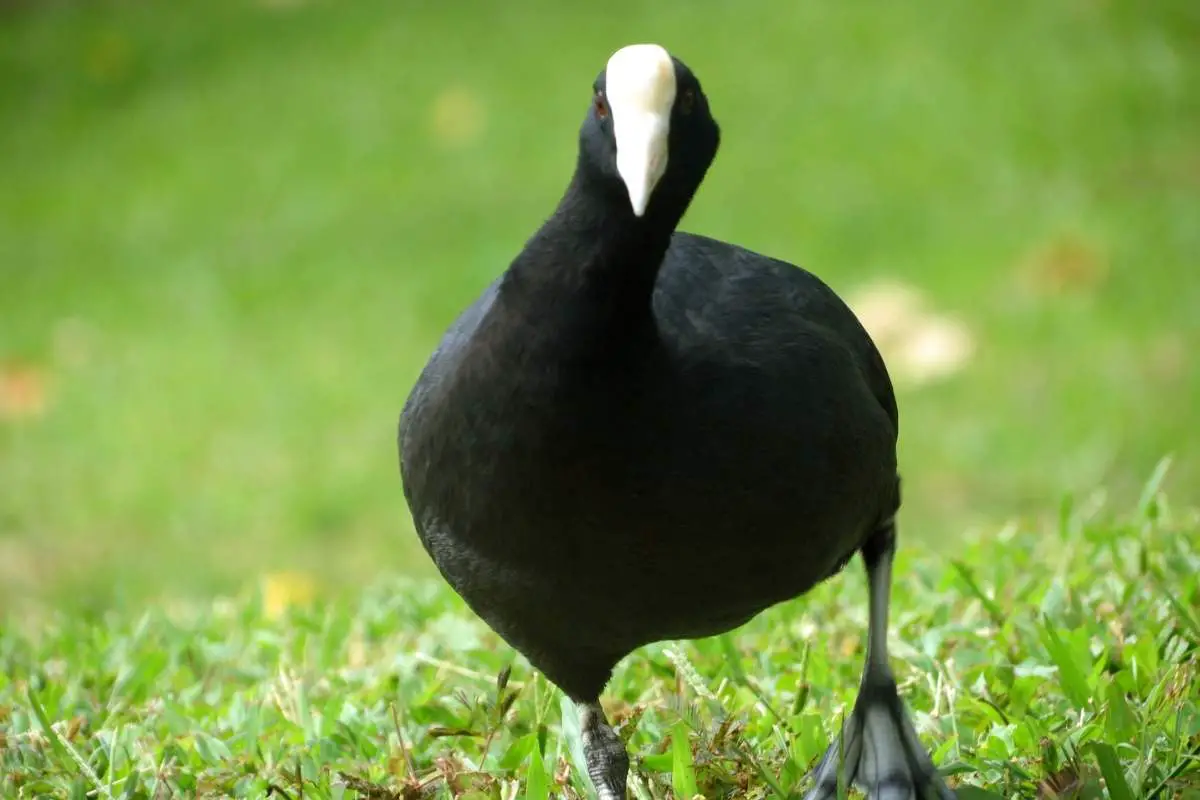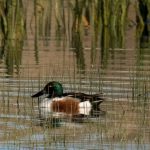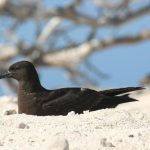Hawaiian coot on grass field | image by Hawaiian Coot via Flickr | CC BY 2.0
Common Name: Hawaiian Coot
Scientific Name: Fulica alai| Size | Diet | Range in Hawaii | Status in Hawaii |
|---|---|---|---|
| 14 in. | aquatic plants, seeds, fruits, insects, snails, worms, and small fish | Big Islands | vulnerable |
The Hawaiian Coot, also known as the ‘alae ke’oke’o in Hawaiian, is a species of bird that is native to the Hawaiian Islands. It is a member of the rail family and is closely related to the American Coot, which is found in North and South America.
Hawaiian Coot
Appearance

The Hawaiian Coot is a medium-sized bird, with a body length of about 14 inches and a wingspan of about 22 inches. It has a distinctive appearance, with a black head, neck, and chest, a white bill, and a black body with a white underside.
Diet
The Hawaiian Coot is an omnivorous bird, meaning it feeds on a wide range of plant and animal matter. Its diet includes a variety of aquatic plants, seeds, fruits, insects, snails, worms, and small fish. The Hawaiian Coot forages for food in the water or on land, using its strong bill to dig for food or to sweep the water for small aquatic animals.
In the wetland habitats where the Hawaiian Coot is found, it is an important seed disperser, helping to spread the seeds of aquatic plants and other wetland vegetation. This helps to maintain the diversity and health of these habitats, which are important for a wide range of species.
Behavior
Hawaiian Coot is a fascinating and unique bird that plays an important role in the wetland ecosystems of the Hawaiian Islands. It is a social bird and is often found in groups or flocks, which can range in size from a few individuals to several hundred birds.
The Hawaiian Coot is a strong swimmer and is often seen swimming or diving in the water to forage for food. It is also a strong flier, and may fly short distances to move between different wetland habitats or to escape predators.
It is known to be territorial and will defend its territory against other birds, particularly during the breeding season. It may engage in aggressive behavior, such as pecking or chasing, to defend its territory or protect its young.
In addition to its territorial behavior, the Hawaiian Coot is also known to engage in courtship displays, such as head-bobbing and vocalizations, to attract a mate. The male and female work together to build the nest and care for the young, with both parents bringing food to the chicks and protecting them from predators.
Nesting
The Hawaiian Coot is a non-migratory bird and breeds throughout the year in the Hawaiian Islands. It typically nests in wetlands, marshes, and other wetland habitats, often building its nest on a small island or floating platform within a wetland.
The female Hawaiian Coot builds the nest, which is made of grasses, reeds, and other plant materials and is lined with feathers. The nest is typically cup-shaped and is built on the ground or slightly above the water level. The female lays a clutch of 3-9 eggs, which are incubated by both the male and female for about 21-25 days.
The Hawaiian Coot is known to be a cooperative breeder, meaning that non-breeding individuals may help to care for the young. This helps to increase the survival rate of the chicks and may also increase the overall reproductive success of the group.
Habitat
The Hawaiian coot is adapted to living in a variety of wetland habitats, including freshwater marshes, estuaries, and coastal lagoons. It is typically found in shallow water and is able to swim and dive to feed on a variety of aquatic plants and animals, such as algae, snails, and insects.
Range in Hawaii
The Hawaiian Coot is a non-migratory bird and is found throughout the main Hawaiian Islands, including Kauai, Oahu, Molokai, Lanai, Maui, and Hawaii.
Conservation Status
The Hawaiian coot is listed as vulnerable due to a combination of factors including habitat loss, habitat degradation, and the introduction of non-native species. These factors have led to a decline in the population of the species, and it is considered to be at risk of extinction.
Conservation efforts for the Hawaiian coot in Hawaii include habitat protection, habitat restoration, and the control of non-native species. These efforts are important for the preservation of Hawaii’s unique ecosystems and the species that depend on them.
Interesting facts
1. Important species in the Hawaiian ecosystem
The Hawaiian coot is an important species in the Hawaiian ecosystem, as it helps to control the populations of aquatic plants and animals. It is also an important food source for a variety of predators, including the Hawaiian hawk and the Hawaiian moorhen.
2. They are non-migratory species
The Hawaiian coot is a non-migratory species, and it is found only in the Hawaiian Islands. It is thought to have evolved from a colonizing ancestor that arrived in the islands millions of years ago.
3. Found in a variety of wetland habitats
The Hawaiian coot is found in a variety of wetland habitats including marshes, ponds, and streams. It feeds on a wide range of plants and animals, including seeds, insects, and small fish.
4. They are a vocal bird
The Hawaiian coot is a vocal bird, and it has a variety of calls including a loud, croaking “kowk-kowk” and a series of honking noises. It is most vocal during the breeding season, when it uses its calls to defend its territory and attract a mate.
Frequently Asked Questions:
Is the Hawaiian coot native to Hawaii?
Yes, the Hawaiian coot is a native species of Hawaii. It is found only in the Hawaiian Islands, and it is thought to have evolved from a colonizing ancestor that arrived in the islands millions of years ago.
How can I identify a Hawaiian coot in Hawaii?
The Hawaiian coot is a medium-sized waterbird that is related to the American coot and the Eurasian coot. It has a black body, a white bill, and a distinctive white patch on the forehead.
What do Hawaiian coots eat in Hawaii?
Hawaiian coots are omnivorous and they feed on a wide range of plants and animals, including seeds, insects, and small fish. They forage for food by diving and swimming underwater, and they are known to be particularly fond of snails and other aquatic invertebrates.
How can I attract Hawaiian coots to my yard in Hawaii?
To attract Hawaiian coots to your yard in Hawaii, you can try providing a source of food and water. Offer a variety of seeds and fruit, and consider installing a bird feeder or birdbath. You can also provide nesting boxes or other types of cover to encourage the coots to stay in your yard.
Are Hawaiian coots protected in Hawaii?
In Hawaii, the Hawaiian coot (Fulica alai) is protected under state law as a vulnerable species. It is illegal to hunt, capture, or kill any native or introduced bird species without a valid hunting or control permit.
The Hawaiian coot is also protected under the federal Migratory Bird Treaty Act, which makes it illegal to take, possess, import, export, transport, sell, purchase, or barter any migratory bird, or any part, nest, or egg of a migratory bird, without a valid permit.




